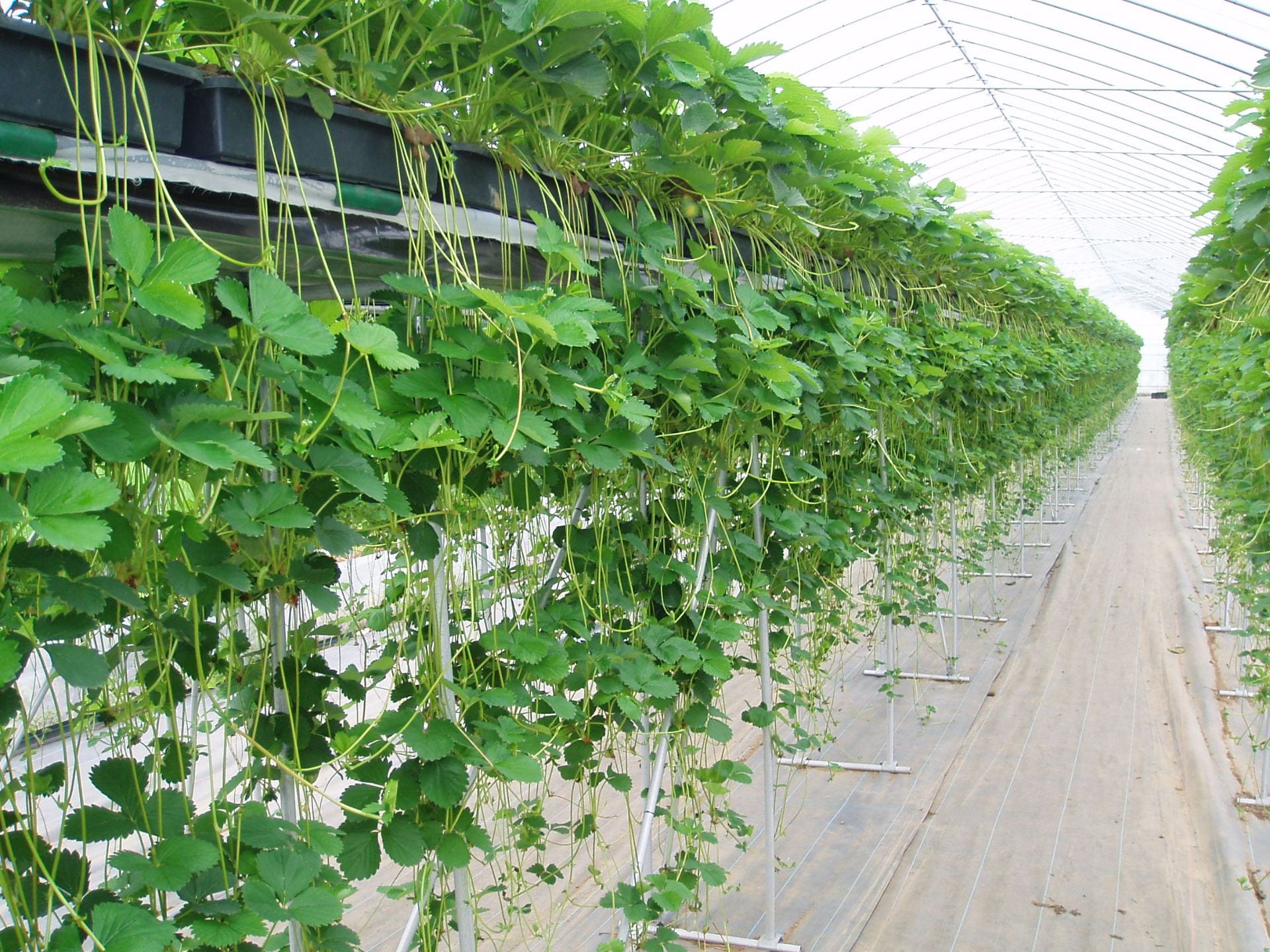Types of starting materials
There are various types of transplants available for strawberry production. However, off-season producers have relatively limited options due to the fact that availability of specific types of planting materials are seasonal and optimized for existing open field production. The above chart shows the available seasons of various types of starting materials in North America. Many cultivars available in the US are proprietary, which requires an appropriate license agreement to propagate. Therefore, growers need to purchase transplants from a nursery who carry the propagation license of the selected cultivar.

Strawberry bare-rooted frigo plants widely used in U.S. (left) and fresh tray plants grown in minimally heated greenhouse packed for shipping in the Netherlands (right)
Bare-rooted frigo plants. These bare-rooted plants are dug out from soil beds in the field in early or mid winter, trimmed to remove leaves and some root length, and stored at -1.5°C for many months. Timing to dig these plants is determined based on the specific chilling hours accumulated in the field recommended for individual cultivars. In North America, frigo plants are typically single-crowned plants and the storability is often limited to 5-6 months (June is the typical end of frigo availability in North America). As these plants are expected to grow further for several months before developing flowers after planting, these frigo plants do not have as many viable flower initials in their meristems. This is a substantial difference in quality between planting materials produced for controlled environment agriculture (greenhouse, tunnels, and indoor farms) and conventional outdoor production.
Bare-rooted fresh dug plants. These bare-rooted plants are dug out from the field in early fall and typically used as planting materials for winter production in Florida and Mexico. For short-day cultivars, plants still need to be exposed to photoperiods shorter than critical length (typically 13 hours or shorter) and/or low temperature suitable for flower initiation.
Runner tips. These daughter plants (unrooted cuttings) are typically produced in propagation beds in Canada (Quebec and Nova Scotia) in late summer and used for producing rooted plugs planted in North America during the fall. Most propagation beds currently used are fumigated soil beds in open fields. However, a small number of greenhouses began propagating runner tips with soilless substrates. These runner tips are called ‘misted runner tips’ and considered as clean propagation materials. Mother plants are grown in a trough placed high (2 meter) above the ground and the runners allowed to grow and hang down.
Rooted runner plugs. Runner tips (daughter plants with visible root initials) are excised and rooted in fresh substrate in a cell tray or small pot under frequent misting. Under frequent misting, rooting will occur within 5-10 days. These rooted runner plus are widely used for planting in high tunnels for better establishment. However, for off-season production in controlled environment, more established large planting materials are preferred. Therefore, fruit producers should grow rooted runner plugs out in greenhouse to have 3-5 true leaves and 1 cm or greater crown diameter before planting into your production system (troughs and containers).
Tray- and mini tray plants. In Belgium and the Netherlands, well-established multi-crowned plants grown for 3-4 months from misted runner tips are called tray plants. These plants have a longer storability at -1.5°C low temperature (e.g., 10-11 months), presumably due to much larger carbohydrate reserve. The frigo plants already have flower initials developed prior to the long storage and so quickly produce fruit after transplanting, allowing off-season production. Specifically, tray plants have ~250 mL substrate volume per plant and mini tray plants have smaller volume (~125 mL). Flower initiation and development are optimized during the propagation using cold temperature and nitrogen management, so that plants are loaded with many viable dormant flower buds that can lead to a large production at a targeted timing (Peter Melis, Personal Communication). Flower initials and their developmental stages of tray plants are evaluated under microscope and this ‘flower mapping’ is considered as a key service of nurseries to assure highly productive off-season strawberry production in Europe.
Conditioned plugs. For short-day cultivars, rooted runner plugs can be treated under low temperature and short day condition to induce flower bud initiation. A typical practice widely used in Japan is to move these plug plants to a cold room (15°C, dark) for 14-16 hours every evening for a period of 3-4 weeks in order to assure an early harvest (such as October or November). Flower initials are confirmed under microscope before final transplanting. In our laboratory, we have used this technique for US short day cultivars to successfully start producing as early as October and November.
Seeds. Seed propagated strawberry cultivars are often hybrids of selected parent cultivars that are near-isogenic lines (NILs). There are several cultivars available in North America but commercial use seems to be limited. Developing NILs in strawberries is a time-consuming process as strawberry has long been propagated vegetatively and has complex polyploidy (8X). Despite the challenge, there have been intensive efforts made in Japan to introduce seed propagated cultivars commercially. Ability of growers to start plants from seeds will become an attractive alternative for off-season strawberry production or in urban greenhouses.

